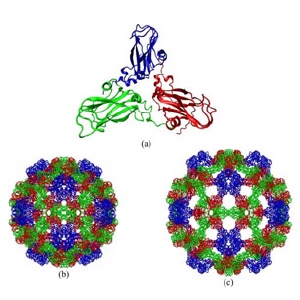Aug 19 2008
The National Science Foundation has awarded chemists from Indiana University Bloomington a $2,925,000 grant to study how viruses pull themselves together.
 This model of a Congenital CytoMegalovirus "protomer" shows how three proteins (blue, red, and green) fit together to form the viral capsule. Many protein complexes in nature self-assemble, meaning their parts spontaneously find and bind to each other. Photo by: Peter Ortoleva
This model of a Congenital CytoMegalovirus "protomer" shows how three proteins (blue, red, and green) fit together to form the viral capsule. Many protein complexes in nature self-assemble, meaning their parts spontaneously find and bind to each other. Photo by: Peter Ortoleva
Martin F. Jarrold, Bogdan Dragnea, Stephen C. Jacobson, Peter J. Ortoleva, James P. Reilly, and their collaborators at the IU Nanoscience Center and Indiana University's Center for Cell and Virus Theory will study how viruses build themselves up from their components, as well as how structural transitions occur in the assembled viruses.
Initially, the scientists wish to understand the fundamentals of viral assembly. In follow-on projects, the IU Bloomington chemists will work on therapeutic applications such as developing virus-like capsules that can enter cells and deliver drugs.
In the lab, virus assembly will be monitored by combining new mass spectrometry techniques with microfluidic devices capable of reaction control and opto-electronic detection. Experimental and theoretical approaches will be integrated via a multiscale approach. The new methods will be tested on a simple plant virus, but what the scientists hope to learn will have applications to human and other viruses.
Students and postdoctoral researchers working on the project will receive cross-disciplinary training. Undergraduate students from Rose-Hulman Institute of Technology in Terre Haute, Ind., and Prairie View A&M University in Texas will work at Indiana University during the summer months (2009 - 2013) and continue their projects at their home institutions during the academic year.
The early phases of this project were supported by the Lilly Endowment Inc. through the Indiana METACyt Initiative, the College of Arts and Sciences, and the Office of the Vice President for Research.